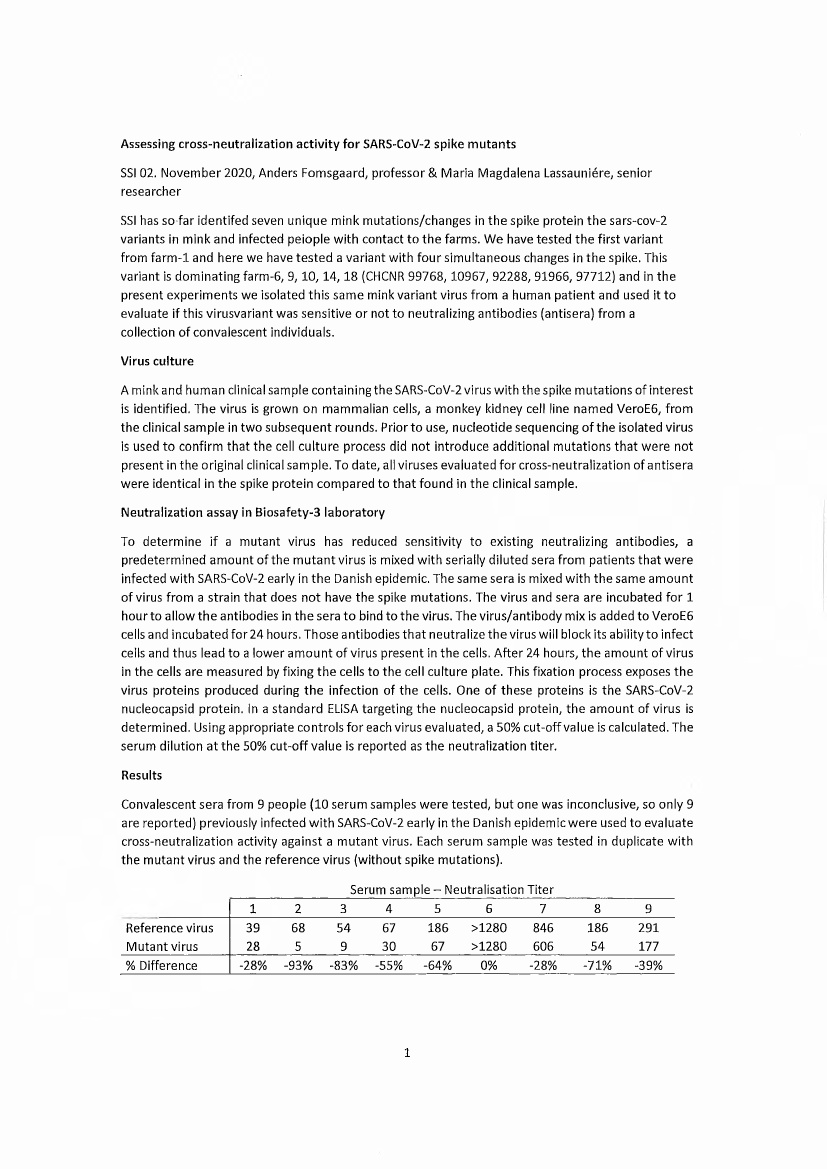
Assessing cross-neutralization activity for SARS-CoV-2 spike mutants
SSI 02. November 2020, Anders Fomsgaard, professor & Maria Magdalena Lassauniere, senior
researcher
SSI has so far identifed seven unique mink mutations/changes in the spike protein the sars-cov-2
variants in mink and infected peiople with contact to the farms. We have tested the first variant
from farm-1 and here we have tested a variant with four simultaneous changes in the spike. This
variant is dominating farm-6, 9, 10, 14, 18 (CHCNR 99768, 10967, 92288, 91966, 97712) and in the
present experiments we isolated this same mink variant virus from a human patient and used it to
evaluate if this virusvariant was sensitive or not to neutralizing antibodies (antisera) from a
collection of convalescent individuals.
Virus culture
A mink and human clinical sample containing the SARS-CoV-2 virus with the spike mutations of interest
is identified. The virus is grown on mammalian cells, a monkey kidney cell line named VeroE6, from
the clinical sample in two subsequent rounds. Priorto use, nucleotide sequencing of the isolated virus
is used to confirm that the cell culture process did not introduce additional mutations that were not
present in the original clinical sample. To date, all viruses evaluated for cross-neutralization of antisera
were identical in the spike protein compared to that found in the clinical sample.
Neutralization assay in Biosafety-3 laboratory
To determine if a mutant virus has reduced sensitivity to existing neutralizing antibodies, a
predetermined amount of the mutant virus is mixed with serially diluted sera from patients that were
infected with SARS-CoV-2 early in the Danish epidemic. The same sera is mixed with the same amount
of virus from a strain that does not have the spike mutations. The virus and sera are incubated for 1
hour to allow the antibodies in the sera to bind to the virus. The virus/antibody mix is added to VeroE6
cells and incubated for 24 hours. Those antibodies that neutralize the virus will block its abilityto infect
cells and thus lead to a lower amount of virus present in the cells. After 24 hours, the amount of virus
in the cells are measured by fixing the cells to the cell culture plate. This fixation process exposes the
virus proteins produced during the infection of the cells. One of these proteins is the SARS-CoV-2
nucleocapsid protein. In a standard ELISA targeting the nucleocapsid protein, the amount of virus is
determined. Using appropriate controls for each virus evaluated, a 50% cut-off value is calculated. The
serum dilution at the 50% cut-off value is reported as the neutralization titer.
Results
Convalescent sera from 9 people (10 serum samples were tested, but one was inconclusive, so only 9
are reported) previously infected with SARS-CoV-2 early in the Danish epidemic were used to evaluate
cross-neutralization activity against a mutant virus. Each serum sample was tested in duplicate with
the mutant virus and the reference virus (without spike mutations).
Serum sample — Neutralisation Titer
1
Reference virus
Mutant virus
% Difference
39
28
-28%
2
68
5
-93%
3
54
9
-83%
4
67
30
-55%
5
186
67
-64%
6
>1280
>1280
0%
7
846
606
-28%
8
186
54
-71%
9
291
177
-39%
1